#Alvarezsauria
Text
Jaculinykus yaruui Kubo et al., 2023 (new genus and species)
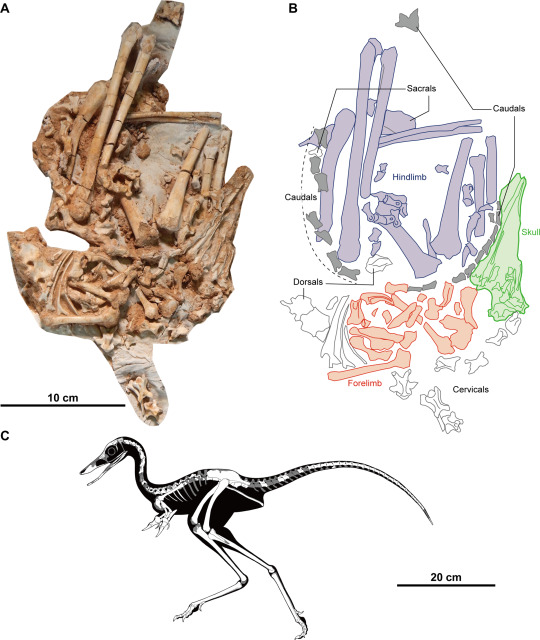
(Type specimen and schematic skeletal of Jaculinykus yaruui, with preserved bones in white on the skeletal, from Kubo et al., 2023)
Meaning of name: Jaculinykus = jaculus [small dragon in Greek mythology] claw [in Greek]; yaruui = speedy [in Mongolian]
Age: Late Cretaceous (Campanian–Maastrichtian?)
Where found: Barun Goyot Formation, Ömnögov, Mongolia
How much is known: Nearly complete skeleton of one individual.
Notes: Jaculinykus was an alvarezsaurid, a group of unusual small theropods with short but powerful forelimbs, each tipped with an enlarged thumb claw. Their other fingers were highly reduced, and in at least one case (Linhenykus), probably lost entirely. Jaculinykus appears to exhibit an intermediate stage in finger loss, having lost one of the smaller fingers on each hand. This makes it the first known example of an alvarezsaurid with two-fingered hands.
Jaculinykus is also one of the most completely known alvarezsaurids. Most of the bones in the type specimen have probably remained close to the original positions that they were held in when the dinosaur died, and they suggest that Jaculinykus slept in a very bird-like posture with the head turned back and tucked close to the body. A similar sleeping pose had previously been found in the troodontid theropods Sinornithoides and Mei, but Jaculinykus provides the first strong evidence that alvarezsaurids (which were more distant relatives of modern birds than troodontids) adopted the same behavior.
Reference: Kubo, K., Y. Kobayashi, T. Chinzorig, and K. Tsogtbaatar. 2023. A new alvarezsaurid dinosaur (Theropoda, Alvarezsauria) from the Upper Cretaceous Baruungoyot Formation of Mongolia provides insights for bird-like sleeping behavior in non-avian dinosaurs. PLoS ONE 18: e0293801. doi: 10.1371/journal.pone.0293801
366 notes
·
View notes
Text
A new alvarezsaurid dinosaur (Theropoda, Alvarezsauria) from the Upper Cretaceous Baruungoyot Formation of Mongolia provides insights for bird-like sleeping behavior in non-avian dinosaurs
Published 15th November 2023
A newly described derived alvarezsaur, Jaculinykus yaruui, from the Late Cretaceous of Mongolia represented by a nearly complete and articulated skeleton with the preserved posture of a stereotypical avian-like sleeping position suggesting that the sleeping postures are a maniraptoran synapomorphy.
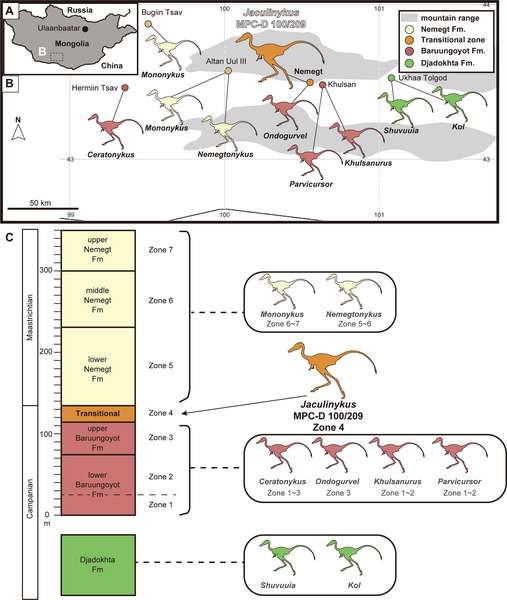
Geographic and stratigraphic occurrence of the Mongolian alvarezsaurids and Jaculinykus yaruui

Holotype of Jaculinykus yaruui and skeletal reconstruction

Evolution of avian-like sleeping posture in theropod dinosaurs, Skeletal disposition of Jaculinykus yaruui and life reconstruction
Source:
4 notes
·
View notes
Text
Notably, the preserved posture of the specimen exhibits a stereotypical avian-like sleeping position seen in the troodontids Mei and Sinornithoides. Evidence of this behavior in the alvarezsaur Jaculinykus suggests that stereotypically avian sleeping postures are a maniraptoran synapomorphy, providing more evidence of bird-like traits being distributed broadly among avian ancestors.
1 note
·
View note
Text
Nemegtonykus citus

By Ripley Cook
Etymology: Nemget Claw
First Described By: Lee et al., 2019
Classification: Dinosauromorpha, Dinosauriformes, Dracohors, Dinosauria, Saurischia, Eusaurischia, Theropoda, Neotheropoda, Averostra, Tetanurae, Orionides, Avetheropoda, Coelurosauria, Tyrannoraptora, Maniraptoromorpha, Maniraptoriformes, Maniraptora, Alvarezsauria, Alvarezsauroidea, Alvarezsauridae, Parvicursorinae
Status: Extinct
Time and Place: 70 million years ago, in the Maastrichtian of the Late Cretaceous


Nemegtonykus is known from the Nemegt Formation of Ömnögovi, Mongolia

Physical Description: Nemegtonykus is known from a partial skeleton, showing a one meter long, lightly built bipedal animal. Like other Alvarezsaurs, it had a long tail and long, thin legs. We don’t know much about its arms or head, but it’s reasonable to suppose it - like other Alvarezsaurs - would have had single thumb claws, and no other digits on its arms; and a small head, ending in a very pointed snout. Parvicursorines, like Nemegtonykus, were of the small and lightly-built vein of Alvarezsaurs - and the apparently much more diverse group - rather than the heavily built Patagonykines. As a small birdie dinosaur, Nemegtonykus would have been covered in feathers, and possibly even had small wing-like feathers on its arms as display structures.
Diet: Alvarezsaur diets is a bit of question - one of the most popular hypotheses is that Alvarezsaurs are insectivores, however there is still a question and they may have been more generalist omnivores.

By José Carlos Cortés
Behavior: Nemegtonykus, as an Alvarezsaur, would have been extremely specialized in speed - its legs were well built for running, both to escape predators and potentially search for prey. It also would have been fairly good at hopping, able to leap out of the way in times of danger or distress. It is possible that the little claws of Nemegtonykus would have been useful in digging up insects or other sources of food out of hard to reach places. Nemegtonykus, like other Alvarezsaurs, would have been a very skittish and anxious animal, using its ability to run to escape danger as quickly as possible. The feathers would have been useful both in thermoregulation (given its small size) and display to other members of the species; and it probably took care of its young to some extent.
Ecosystem: Nemegtonykus lived in the famous and diverse Nemegt Formation, an environment filled to bursting with different kinds of dinosaurs and other prehistoric creatures. This was a vast wetland, flooded with river channels that created extensive lakes, mudflats, and floodplains, much like the modern Okavango Delta in Botswana. This swamp field was surrounded by extensive coniferous forests, where the ground became somewhat drier. This was an area of animals highly specialized for their environment - especially creatures specialized for feeding on water plants, making them all various kinds of vaguely-duck-like animals. There was Duck Satan Deinocheirus, and the ornithomimosaurs Gallimimus and Answerimimus who also had duck-like bills for feeding on soft plants. There was the Hadrosaur (Duck-Billed Dinosaur) Saurolophus, which also fed on soft, mushy plants; and the actual early duck-like thing, Teviornis. In terms of non-duck dinosaurs, there was the large tyrannosaur Tarbosaurus and the smaller Alioramus; Troodontids like Tochisaurus, Zanabazar, and Borogovia; a million kind of chickenparrots like Avimimus, Elmisaurus, Conchoraptor, Nemegtomaia, Nomingia, and Rinchenia; the Hesperornithine Brodavis; Pachycephalosaurs like Homalocephale and Prenocephale; Ankylosaurs such as Tarchia and Saichania; the titanosaur Nemegtosaurus; the Therizinosaur Therizinosaurus; the raptor Adasaurus; and another Alvarezsaur - Mononykus. There was also an Azhdarchid pterosaur, the mammal Buginbaatar, and a variety of crocodilians and turtles.

By Scott Reid
Other: Nemegtonykus was found alongside a specimen of Mononykus, potentially indicating that different Alvarezsaurs potentially socialized with each other, or at least didn’t avoid each other within their shared habitats. This may also indicate a level of niche partitioning between different Alvarezsaurs.
~ By Meig Dickson
Sources Under the Cut
Arbour, V. M., Currie, P. J. and Badamgarav, D. (2014), The ankylosaurid dinosaurs of the Upper Cretaceous Baruungoyot and Nemegt formations of Mongolia. Zoological Journal of the Linnean Society, 172: 631–652.
Barsbold, R. (1983). “Carnivorous dinosaurs from the Cretaceous of Mongolia [in Russian].” Trudy, Sovmestnaâ Sovetsko−Mongol’skaâ paleontologičeskaâ èkspediciâ, 19: 1–120.
Chinzorig, T., Kobayashi, Y., Tsogtbaatar, K., Currie, P.J., Takasaki, R., Tanaka, T., Iijima, M., Barsbold, R. 2017. Ornithomimosaurs from the Nemegt Formation of Mongolia: manus morphological variation and diversity. Palaeogeography, Palaeoclimatology, Palaeoecology 494: 91 - 100.
Choiniere, J.N.; Xu, X.; Clark, J.M.; Forster, C.A.; Guo, Y.; Han, F. (2010). "A basal alvarezsauroid theropod from the early Late Jurassic of Xinjiang, China". Science. 327 (5965): 571–574.
Fanti, F., Bell, P.R., Tighe, M., Milan, L.A., Dinelli, E. 2017. Geochemical fingerprinting as a tool for repatriating poached dinoaur fossils in Mongolia: A case study for the Nemegt Locality, Gobi Desert. Palaeogeography, Palaeoclimatology, Palaeoecology 494: 51 - 64.
Fowler DW, Woodward HN, Freedman EA, Larson PL, Horner JR (2011) Reanalysis of “Raptorex kriegsteini”: A Juvenile Tyrannosaurid Dinosaur from Mongolia. PLoS ONE 6(6): e21376.
Funston, G. F.; Mendonca, S. E.; Currie, P. J.; Barsbold, R. (2017). “Oviraptorosaur anatomy, diversity and ecology in the Nemegt Basin”. Palaeogeography, Palaeoclimatology, Palaeoecology.
Gradzinski, R., J. Kazmierczak, J. Lefeld. 1968. Geographical and geological data form the Polish-Mongolian Palaeontological Expeditions. Palaeontologia Polonica 198: 33 - 82.
Holtz, Thomas R., Jr. (2007). "Ornithomimosaurs and Alvarezsaurs". Dinosaurs: The Most Complete, Up-to-Date Encyclopedia for Dinosaur Lovers of All Ages.
Holtz, T.R. 2014. Paleontology: Mystery of the horrible hands solved. Nature 515 (7526): 203 - 205.
Hurum, J. 2001. Lower jaw of Gallimimus bullatus. In Tanke, D. H., K. Carpenter, M. W. Skrepnick. Mesozoic Vertebrate Life. Bloomington: Indiana University Press. 34 - 41.
Jerzykiewicz, T., Russell, D.A. 1991. Late Mesozoic stratigraphy and vertebrates of the Gobi Basin. Cretaceous Reserch 12 (4): 346 - 377.
Kielan-Jaworowska, Z. 1969. Fossils from the Gobi desert. Science Journal 5(1):32-38.
Kielan-Jaworowska, Z., R. Barsbold. 1972. Narrative of the Polish-Mongolian Palaeontological Expeditions 1967-1971. Palaeontologia Polonica 27: 5 - 136.
Kobayashi, Y., Barsbold, R. 2006. Ornithomimids from the Nemegt Formation of Mongolia. Journal of the Paleontological Society of Korea 22 (1): 195 - 207.
Lee, Y.N., Barsbold, R., Currie, P.J., Kobayashi, Y., Lee, H.J. 2013. New specimens of Deinocherus mirificus from the Late Cretaceous of Mongolia. Society of Vertebrate Paleontology Abstracts of Papers: 161.
Lee, Y.N., Barsbold, R., Currie, P.J., Kobayashi, Y., Lee, H.J., Godefroit, P., Escuillie, F.O., Chinzorig, T. 2014. Resolving the long-standing enigmas of a giant ornithomimosaur Deinocheirus mirificus. Nature 515 (7526): 257 - 260.
Lee, S., J.-Y. Park, Y.-N. Lee, S.-H. Kim, J. Lü, R. Barsbold, K. Tsogtbaatar. 2019. A New Alvarezsaurid Dinosaur from the Nemegt Formation of Mongolia. Scientific Reports 9: 15493.
Lü, JC; Xu, L; Chang, HL; Jia, SH; Zhang, JM; Gao, DS; Zhang, YY; Zhang, CJ; Ding, F (2018). "A new alvarezsaurid dinosaur from the Late Cretaceous Qiupa Formation of Luanchuan, Henan Province, central China". China Geology. 1: 28–35.
Newbrey, M. G., Donald B. Brinkman, Dale A. Winkler, Elizabeth A. Freedman, Andrew G. Neuman, Denver W. Fowler and Holly N. Woodward (2013). “Teleost centrum and jaw elements from the Upper Cretaceous Nemegt Formation (Campanian-Maastrichtian) of Mongolia and a re-identification of the fish centrum found with the theropod Raptorex kreigsteini”. In Gloria Arratia; Hans-Peter Schultze; Mark V. H. Wilson (eds.). Mesozoic Fishes 5 – Global Diversity and Evolution. Verlag Dr. Friedrich Pfeil. pp. 291–303.
Schweitzer, Mary Higby, Watt, J.A., Avci, R., Knapp, L., Chiappe, L, Norell, Mark A., Marshall, M. (1999). "Beta-Keratin Specific Immunological reactivity in Feather-Like Structures of the Cretaceous Alvarezsaurid, Shuvuuia deserti Journal of Experimental Biology (Mol Dev Evol) 255:146-157.
Shuvalov, V.F. (2000). “The Cretaceous stratigraphy and palaeobiogeography of Mongolia”. In Benton, Michael J.; Shishkin, Mikhail A.; Unwin, D.M.; Kurochkin, E.N. (eds.). The Age of Dinosaurs in Russia and Mongolia. Cambridge University Press. pp. 256–278.
Takanobu Tsuihiji, Brian Andres, Patrick M. O'connor, Mahito Watabe, Khishigjav Tsogtbaatar & Buuvei Mainbayar (2017) Gigantic pterosaurian remains from the Upper Cretaceous of Mongolia, Journal of Vertebrate Paleontology.
Turner, Alan H.; Pol, Diego; Clarke, Julia A; Erickson, Gregory M.; Norell, Mark (2007). "A basal dromaeosaurid and size evolution preceding avian flight". Science. 317 (5843): 1378–1381.
Watabe, M., S. Suzuki, K. Tsogtbaatar, T. Tsubamoto, M. Saneyoshi. 2010. Report of the HMNS-MPC Joint Paleontological Expedition in 2006. Hayashibara Museum of Natural Sciences Reasearch Bulletin 3:11 - 18.
Watanabe, A., Eugenia Leone Gold, M., Brusatte, S.L., Benson, R.B.J., Choiniere, J., Davidson, A., Norell, M.A., Claessens, L. 2015. Vertebral pneumaticity in the ornithomimosaur Archaeornithomimus (Dinosauria: Theropoda) revealed by computed tomography imaging and reappraisal of axial pneumaticity in ornithomimosuria. PLoS ONE 10 (12): e0145168.
Zelenitsky, D K., F. Therrien, G. M. Erickson, C. L. DeBuhr, Y. Kobayashi, D. A. Eberth, F. Hadfield. 2012. Feathered non-avian dinosaurs from North America provide insight into wing origins. Science 338 (6106): 510 - 514.
#Nemegtonykus#Nemegtonykus citus#Alvarezsaur#Dinosaur#Palaeoblr#Prehistoric Life#prehistory#paleontology#Factfile#Cretaceous#Eurasia#Omnivore#Theropod Thursday#Maniraptoran#dinosaurs#biology#a dinosaur a day#a-dinosaur-a-day#dinosaur of the day#dinosaur-of-the-day#science#nature
237 notes
·
View notes
Link


An article published in the journal "Current Biology" describes the discovery of two species of dinosaurs belonging to the Alvarezsauria group, which shares many characteristics with modern birds, in north-western China. A team of researchers studied the fossils of the species that were named Xiyunykus pengi and Bannykus wulatensis recognizing some characteristics intermediate between the oldest species of that group and others that lived several million years later, showing for example how the morphology of their arms evolved slowly.
0 notes
Photo
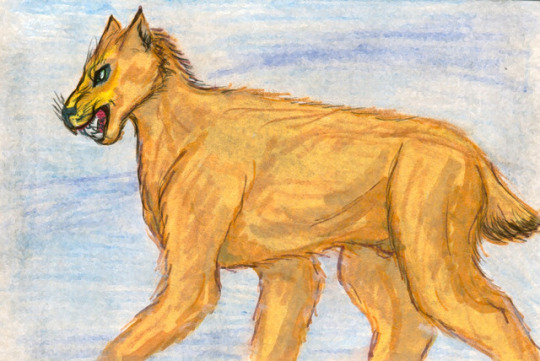

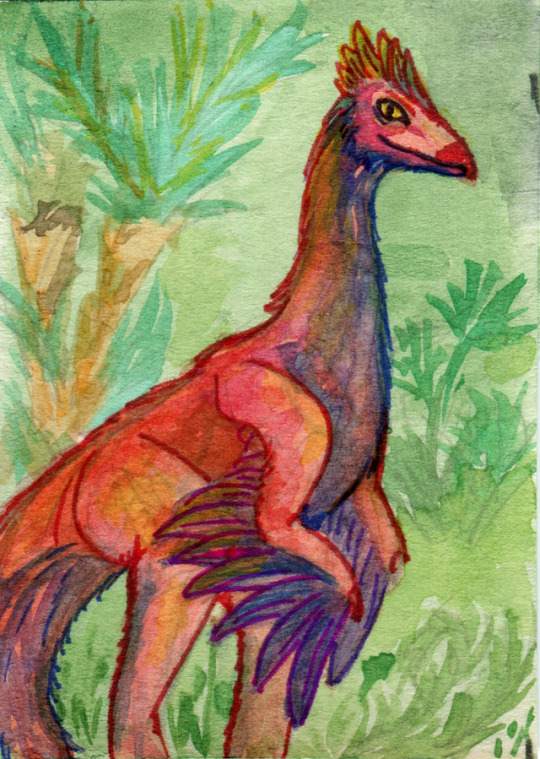
Pantherinae, Alvarezsauria and anthro owl Sergey XD
5 notes
·
View notes
Text
Palaeontologists Have Unearthed a Distinctive Hook-Clawed Dinosaur in Montana
https://sciencespies.com/nature/palaeontologists-have-unearthed-a-distinctive-hook-clawed-dinosaur-in-montana/
Palaeontologists Have Unearthed a Distinctive Hook-Clawed Dinosaur in Montana
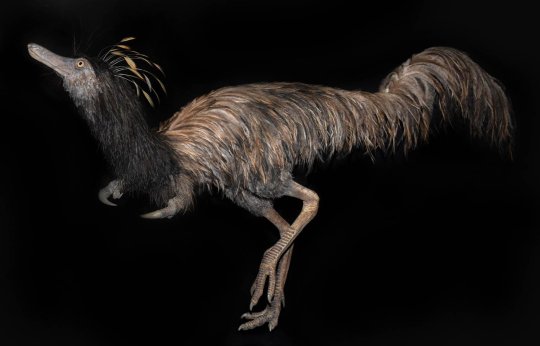
From the depths of time, out of the Hell Creek Formation, emerged the last of the hook-handed dinosaurs: Captain Hook… of the Prairie.
This fearsome creature had a tooth-filled snout and large, viciously hooked claws. But each talon sat at the end of the most ridiculously short and stubby, single-fingered hand.
For all its sharp bits and absurd limbs, Trierarchuncus prairiensis may have in fact been rather cute – if researchers’ impressions of what it may have looked like can be believed – thanks to its primitive feather fluff and long tail.
It was only about three metres long – tiny compared to many of the other giant beasts that have been discovered in the Hell Creek rock formation, including many T. rex and Triceratops.
Daily sketch: Trierarchuncus prairiensis Fowler 2020, newly described late Cretaceous #alvarezsaurid, here doing some goofy display dance. #sciart #paleoart #dinosaur pic.twitter.com/gt8yZ6WIsW
— Filipe Martinho (@martinhfilipe) July 13, 2020
T. prairiensis’s small simple teeth suggest they once stalked seas of grass, beside these larger beasts, in what’s now Montana, USA, in search of precious tasty insect treasures to gobble, during the late cretaceous period 66 million years ago.
The group Alvarezsauria was previously only known from fragments and isolated fossils found in Asia and South America. Palaeontologists have now published a new paper on their discovery of a series of claws belonging to this newly named species.
Its name is made up of ‘trierarch’, a seafaring ship’s captain in Greek, and ‘uncus’ meaning hook in Latin, translating to ‘Captain Hook of the Prairie’.
The fluffy dinosaur’s hooked claws are thought to have been for tearing apart vegetation, insect nests, and rotting wood – rather like anteater claws.

(Boban Filipovic)
Palaeontologist Denver Fowler from the Badlands Dinosaur Museum and colleagues found the fossils in the uppermost layer of the Hell Creek Formation, making them the youngest known alvarezsaurid dinosaurs and among the last non-avian dinosaurs known to have existed before the infamous mass extinction event that wiped them out.
They are members of a dinosaur group called maniraptorans, which also includes dinosaurs that evolved into birds.
The series of forelimb claw fossils don’t belong to one individual, because these ancient, weird creatures only had one finger – a thumb attached to tiny but powerful arms.
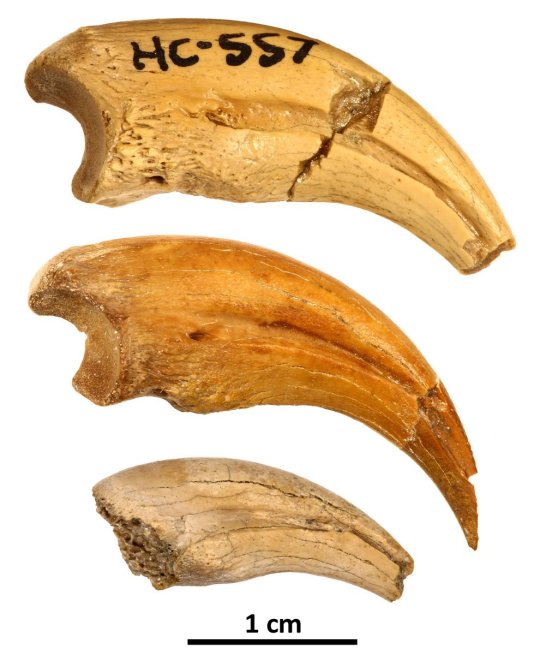
The three claws showing changes in shape and texture as the animal grew in size. (Fowler et al, Cretaceous Research, 2020)
“The new fossils represent a growth series from juvenile to adult,” the researchers explain in a press release.
“The fossils show that as Trierarchuncus grew its hand claw became more robust; blood vessel grooves on the sides of the claw became more deeply embedded in bone; and the claw surface developed from being smooth in young individuals, into a rough surface texture in adults.”
These changes are significant because researchers have used such features to classify the different alvarezsaurid species. Some previous finds in this group may have been classified according to their juvenile forms – potentially making their classification inaccurate.
“Dinosaurs changed significantly through development,” the researchers explain in their paper. “Young individuals may appear morphologically more similar to their ancestors than to adults of their own species.”
An important point for palaeontologists to keep in mind when sorting which fossil belongs to which species.
This research was published in Cretaceous Research.
#Nature
0 notes
Text
Researchers Discover Two New Chinese Dinosaurs: Bannykus computer and Xiyunykus
www.inhandnetworks.com
Bannykus restoration (Image by SHI Aijuan)
Digit reduction occurs many times in tetrapod evolution, and the most famous example is the ‘horse series’ of North America. An international research team announced the discovery of two new Chinese dinosaurs: Bannykus and Xiyunykus, in the journal Current Biology, which shed light on how alvarezsaurian dinosaurs reduced and lost their fingers.
The new dinosaurs are based on two fossils collected by a joint research team led by XU Xing from the Institute of Vertebrate Palaeontology and Palaeoanthropology (IVPP) of the Chinese Academy of Sciences. Xiynykus was discovered in 2005 in Zhunggar Basin, northwestern China, and Bannykus was discovered a few years later in 2009 in western Inner Mongolia, north-central China.
The new Alvarezsaurian dinosaurs are among the most bizarre groups of theropods, with extremely short, robust forelimbs with a single functional claw and gracile, bird-like skulls and hindlimbs. These specializations have led to controversy about their phylogenetic placement, biogeographic history, and ecological role in Mesozoic ecosystems.
AT early times, unspecialized alvarezsaur fossils were the key to resolving this controversy, but until recently the group had at least a 90 million year gap in its fossil record, especially during the Early Cretaceous.
Bizarre hand of Bannykus (Image by XU Xing)
The new dinosaurs fall nearly at the midpoint of the 90-million year temporal gap between the earliest and latest alvarezsaurs. They contribute key phylogenetic and biogeographic information that firmly resolves Alvarezsauria as a monophyletic clade originating in Asia and dispersing to other continents.
The new findings show that clear anatomical specializations also present in later members of the clade, such as a hypertrophied first digit, mechanically efficient forearm, and robust humerus. However, they preserve plesiomorphic forelimb proportions not present in later-branching members.
Xiyunykus skeleton line drawing (Image by SHI Aijuan)
Together, these observations document a major macroevolutionary shift from the plesiomorphic theropod condition of a relatively long arm and grasping hand in the earliest alvarezsaurs (e.g., Haplocheirus), to a long arm with a specialized hand in Bannykus and Xiyunykus, to the highly specialized short-l Vending Computer imbed, functionally monodactyl hand in the latest evolving members of the clade. “This transition plays out in an incremental fashion over more than 50 million years,” said XU, “it could one day potentially serve as a classic example of macroevolution akin to the ‘horse series’ of North America.” “Alvarezsaurs are weird animals,” said Dr. Jonah Choiniere from the University of the Witwatersrand of South Africa, a co-author of the report, “with their strong, clawed hands and weak jaws, they appear to be the dinosaurian analogue to today’s aardvarks and anteaters.”
But the earliest alvarezsaurs had more typical, meat-eating teeth and hands useful for catching small prey, and only later-evolving alvarezsaurs evolved a hand with a huge, single claw capable perhaps of tearing open rotting logs and anthills. Bannykus and Xiyunykus are important because they show transitional steps in the process of alvarezsaurs adapting to new diets. “The fossil record is the best source of information about how anatomical features evolve,” said James Clark from George Washington University, “and like other classic examples of evolcashless vendingution such as the ‘horse series,’ these dinosaur Overhead Line Monitoring s show us how a lineage can make a major shift in its ecology over time.”
From left to right: Haplocheirus, Xiyunykus, Bannykus, and Shuvuuia. Note the lengthening of the jaws, reduction of the teeth, and changes in the hand and arm. Viktor Radermacher
Dr. Roger Benson from the University of Oxford said, “The new fossils have long arms, showing that alvarezsaurs evolved short arms only later in their evolutionary history, in species with small body sizes. This is quite different to what happens in the classic example of tyrannosaurs, which have short arms and giant size.”
Publication: Xing Xu, et al., “Two Early Cretaceous Fossils Document Transitional Stages in Alvarezsaurian Dinosaur Evolution,” Current Biology, 2018; DOI:10.1016/j.cub.2018.07.057
din rail mounting, ul certified, fcc certified, ptcrb certified, verizon wireless certified, att certified, ce certified-, emark certified, azure iot certified, cost effective, ipv6, python programming, reliability, security, high-speed, lte cat 1, router, gateway, routers, cellular gateway, modem, hardware, software, cloud platform, applications, ethernet switch, managed switch, vehicle router, car router, dtu, data terminal unit, computer, vending computer, vending pc, manufacturer, manufacturing, android computer, iot, industrial iot, industrial internet of things, m2m, industrial m2m, m2m communication, remote communication, wireless m2m, remote connectivity, remote access, m2m connectivity, iiot, industrial networking, industrial wireless, m2m iot, smart vending, touchscreen vending, cloud vms, telemeter, vending telemetry, cashless vending, light industrial, commercial, distribution automation, distribution power line monitoring, fault location, fault detection, da monitoring, smart grid, transformer monitoring, intelligent substation, goose messaging, remote machine monitoring, remote secure networks, remote secure networking, secure web based scada , remote diagnostics, remote maintenance, plc programming, intelligent traffic enforcement, ct scanners remote monitoring, mri remote monitoring, healthcare, wireless atm, branch networking, retail, digital signage, wastewater treatment, remote monitoring, industrial automation, automation, industrial transport, inhand, inhand network, inhand networks, Industrial IoT, IIoT, Industrial IoT Manufacturer, Industrial IoT Connectivity, Industrial IoT Products, Industrial IoT Solutions, Industrial IoT Products, industrial IoT Gateway, industrial IoT router, M2M IoT gateway, M2M IoT router, industrial router, Industrial IoT Router/Gateway, industrial IoT Gateway, industrial LTE router, Industrial VPN router, Dual SIM M2M router, Entry level Industrial Router, Cost effective, 3G 4G LTE, WiFi, VPN industrial router for commercial and industrial and M2M/IoT applications, Industrial 3G Router,
#intelligent-traffic-enforcement#low-cost cellular router#wireless ATM modem#Dual SIM M2M router#industrial cellular modem3g modem#Remote Automation#industrial l2tp cellular router#wireless ATM solutions
0 notes
Text
Ondogurvel alifanovi Averianov & Lopatin, 2022 (new genus and species)
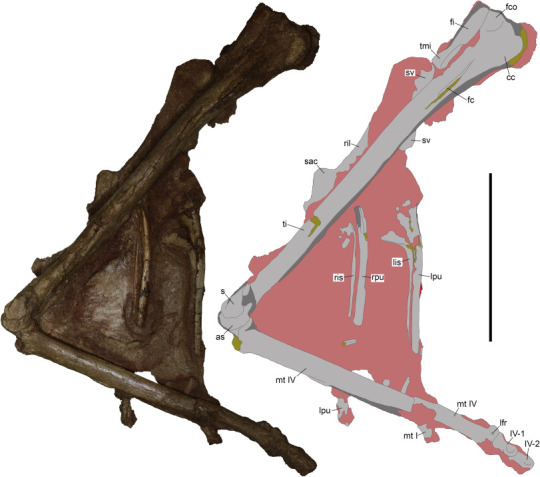
(Type specimen of Ondogurvel alifanovi [scale bar = 50 mm], from Averianov and Lopatin, 2022)
Meaning of name: Ondogurvel = egg lizard; alifanovi = for Vladimir Alifanov [Russian paleontologist and discoverer of the original fossil, who passed away in 2021]
Age: Late Cretaceous (Campanian–Maastrichtian?)
Where found: Barun Goyot Formation, Ömnögov, Mongolia
How much is known: Partial skeleton of one individual, including some vertebrae and parts of the limbs.
Notes: Ondogurvel was an alvarezsaurid, a group of unusual, small-bodied theropods with short but powerful forelimbs, each tipped with an enlarged thumb claw. Their other fingers were highly reduced (and in some cases apparently lost entirely).
Many alvarezsaurids have been described from the Late Cretaceous of Asia, but Ondogurvel can be distinguished from the others by several features, notably the fact that two of its metatarsals in each foot were fused together across most of their length. (In other alvarezsaurids, the metatarsals were either unfused or only fused to a limited extent.) It was probably fairly closely related to Mononykus, sharing with it a distinctive hand structure in which the reduced fingers were probably oriented at almost right angles from the thumb (instead of being roughly parallel to it).
Reference: Averianov, A.O. and A.V. Lopatin. 2022. A new alvarezsaurid theropod dinosaur from the Upper Cretaceous of Gobi Desert, Mongolia. Cretaceous Research advance online publication. doi: 10.1016/j.cretres.2022.105168
40 notes
·
View notes
Text
Dzharaonyx eski Averianov & Sues, 2022 (new genus and species)
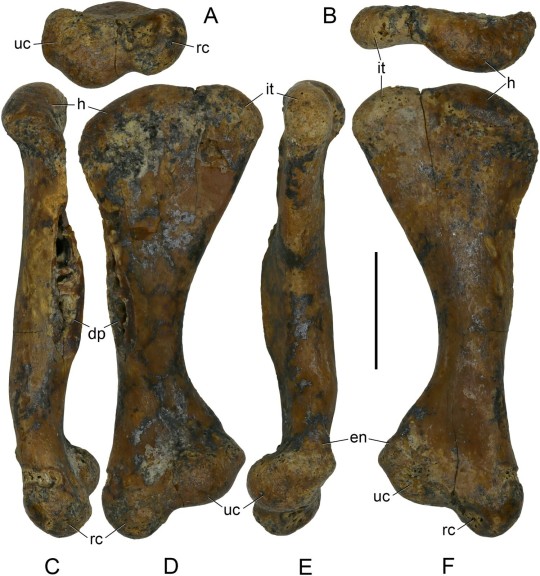
(Type humerus [upper arm bone] of Dzharaonyx eski [scale bar = 5 mm], from Averianov and Sues, 2022)
Meaning of name: Dzharaonyx = Dzharakuduk claw [in Greek]; eski = old [in Uzbek]
Age: Late Cretaceous (Turonian)
Where found: Bissekty Formation, Navoiy, Uzbekistan
How much is known: Numerous isolated bones, including vertebrae and limb bones.
Notes: Dzharaonyx was an alvarezsaurid, a group of unusual small theropods with short but powerful forelimbs, each tipped with an enlarged thumb claw. Some remains of Dzharaonyx, including tail vertebrae and hand bones, had been previously described in 2017, but had been left unnamed. A new study reports several new specimens that exhibit enough distinctive features to be recognized as a distinct species. Dzharaonyx is the oldest known member of the Parvicursorinae, a group of alvarezsaurids known for their reduced body size (ranging from pigeon- to turkey-sized) and increased specializations for running.

(Thumb claws of Dzharaonyx eski [scale bars = 3 mm], from Averianov and Sues, 2022)
Reference: Averianov, A.O. and H.-D. Sues. 2022. New material and diagnosis of a new taxon of alvarezsaurid (Dinosauria, Theropoda) from the Upper Cretaceous Bissekty Formation of Uzbekistan. Journal of Vertebrate Paleontology advance online publication. doi: 10.1080/02724634.2021.2036174
22 notes
·
View notes
Text
Khulsanurus magnificus Averianov & Lopatin, 2021 (new genus and species)

(Type specimen of Khulsanurus magnificus, from Averianov and Lopatin, 2021)
Meaning of name: Khulsanurus = Khulsan tail; magnificus = magnificent
Age: Late Cretaceous (Campanian–Maastrichtian?)
Where found: Barun Goyot Formation, Ömnögov, Mongolia
How much is known: Partial skeleton of one individual, including parts of the forelimbs, vertebrae, and hips.
Notes: Khulsanurus was an alvarezsaurid, a group of unusual, small-bodied theropods with short but powerful forelimbs, each tipped with an enlarged thumb claw. They are generally thought to have been insectivores that used their forelimbs to break open rotting wood and other hard substrates in search of prey.
Khulsanurus is known from the same locality as another genus of alvarezsaurid, Parvicursor. The two were probably relatively closely related, but differed from each other in the shape of their vertebrae.
Reference: Averianov, A.O. and A.V. Lopatin. 2021. The second taxon of alvarezsaurid theropod dinosaurs from the Late Cretaceous Khulsan locality in Gobi Desert, Mongolia. Historical Biology advance online publication. doi: 10.1080/08912963.2021.2000976
26 notes
·
View notes
Text
Heptasteornis andrewsi

By José Carlos Cortés
Etymology: Transylvanian Bird
First Described By: Harrison & Walker, 1975
Classification: Dinosauromorpha, Dinosauriformes, Dracohors, Dinosauria, Saurischia, Eusaurischia, Theropoda, Neotheropoda, Averostra, Tetanurae, Orionides, Avetheropoda, Coelurosauria, Tyrannoraptora, Maniraptoromorpha, Maniraptoriformes, Maniraptora, Alvarezsauria, Alvarezsauroidea, Alvarezsauridae
Status: Extinct
Time and Place: Between 68 and 66 million years ago, in the Maastrichtian of the Late Cretaceous

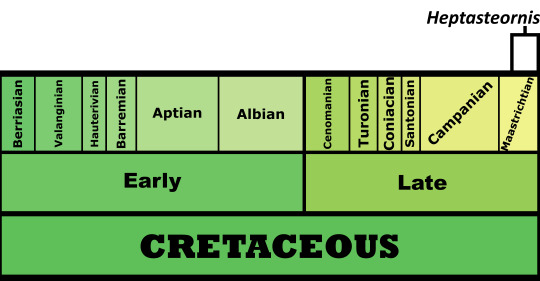
Heptasteornis is known from the Sânpetru Formation of Haţeg Basin

Physical Description: Heptasteornis is not very well known, poorly preserved to the point of it being uncertain what sort of dinosaur it actually was. It was some sort of small Maniraptoran - known from scattered remains, our best guess at the moment seems to be that it was an Alvarezsaur. As an Alvarezsaur, it would have been a small, fluffy animal - with very short arms, ending in a single finger with a sharp claw. It would have had long, skinny legs, and a long neck. Its head would have probably been small. Beyond that, specifics are unknown. It’s possible that it would have had small wings on its tiny arms - for display, and rather useless for anything else.
Diet: The diet of Alvarezsaurs is actually something of a question - assuming, of course, that Heptasteornis was one, it would probably match the other members of its group. One of the most popular hypotheses is that these dinosaurs are insectivores, but until more is known, we should probably go with the null hypothesis of omnivore.
Behavior: The behavior of Heptasteornis is a bit uncertain - not only because we don’t know what sort of dinosaur it is, but because the behavior of Alvarezsaurs is somewhat dubious. It used to be thought that they dug their way to food with their little claws, but that’s just one hypothesis. Regardless, Heptasteornis would probably have been a somewhat skittish, bird-like animal, energetic and using running as its main method of escape from danger. It also probably would have taken care of its young, and used feathers in both thermoregulation and display.
Ecosystem: Heptasteornis was part of the famed Haţeg Island Fauna, one of the weirder ecologies found right before the end of the Cretaceous period. This was a weird river environment on a small island, with a variety of ferns, moss, clubmoss, horsetails, ginkgos, and magnolia flowers. And there were weirdos in terms of animals - tiny dinosaurs, giant pterosaurs, the whole shebang. There were a wide variety of amphibians, turtles, lizards, snakes, and mammals there. There were also crocodyliformes like Allodaposuchus and Sabresuchus, some sort of large pterosaur, and other dinosaurs like the fast-moving ankylosaur Struthiosaurus, the large hadrosaur-like Telmatosaurus, the Rhabdodont Zalmoxes, the small titanosaur Magyarosaurus, another Alvarezsaur by the name of Bradycneme, a miscellaneous maniraptoran called Elopteryx, and a troodontid named Euronychodon.
Other: Heptasteornis was originally thought to be a bird - hence the name - before its current classification as an Alvarezsaur. Still, pretty bird-like in the end. It is one of the first Alvarezsaurs (probably) that was found in Europe.
~ By Meig Dickson
Sources under the Cut
Andrews, C.W. (1913): On some bird remains from the Upper Cretaceous of Transylvania. Geological Magazine 5: 193-196.
Csiki, G. & Grigorescu, D. (1998): Small theropods from the Late Cretaceous of the Hateg Basin (western Romania) - an unexpected diversity at the top of the food chain. Oryctos 1: 87-104.
Harrison, Colin James Oliver & Walker, Cyril Alexander (1975): The Bradycnemidae, a new family of owls from the Upper Cretaceous of Romania. Palaeontology 18(3): 563-570.
Holtz, Thomas R., Jr. (2007). "Ornithomimosaurs and Alvarezsaurs". Dinosaurs: The Most Complete, Up-to-Date Encyclopedia for Dinosaur Lovers of All Ages.
Le Loeuff, J.; Buffetaut, E.; Méchin, P. & Méchin-Salessy, A. (1992): The first record of dromaeosaurid dinosaurs (Saurischia, Theropoda) in the Maastrichtian of southern Europe: palaeobiogeographical implications. Bulletin de la Société géologique de la France 163(3): 337-343.
Naish, Darren & Dyke, Gareth J. (2004): Heptasteornis was no ornithomimid, troodontid, dromaeosaurid or owl: the first alvarezsaurid (Dinosauria: Theropoda) from Europe. Neues Jahrbuch für Geologie und Paläontologie Monatshefte 7: 385-401.
Paul, Gregory S. (1988): Predatory Dinosaurs of the World. New York, Simon & Schuster.
Weishampel, D.B.; Grigorescu, D. & Norman, D.B. (1991): The dinosaurs of Transylvania. National Geographic Research and Exploration 7(2): 196-215.
Weishampel, David B.; Dodson, Peter; and Osmólska, Halszka (eds.): The Dinosauria, 2nd, Berkeley: University of California Press. 861 pp.
#Heptasteornis andrewsi#Heptasteornis#Alvarezsaur#Maniraptoran#Dinosaur#Dinosaurs#Prehistoric Life#Prehistory#Paleontology#Omnivore#Insectivore#Feathered Dinosaurs#Eurasia#Cretaceous#Mesozoic Monday#biology#a dinosaur a day#a-dinosaur-a-day#dinosaur of the day#dinosaur-of-the-day#science#nature#factfile
130 notes
·
View notes
Link
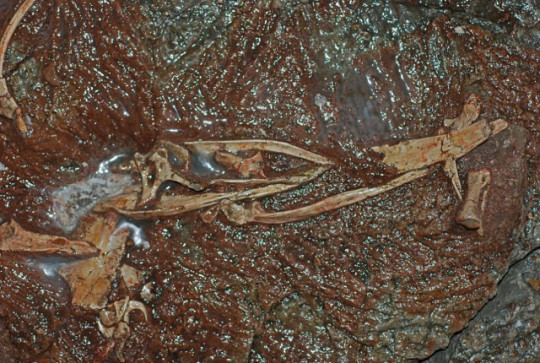
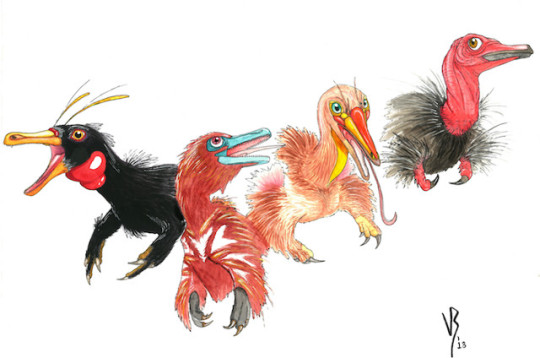
Un articolo pubblicato sulla rivista "Current Biology" descrive la scoperta di due specie di dinosauri appartenenti al gruppo Alvarezsauria, che condivide molte caratteristiche con i moderni uccelli, nella Cina nord-occidentale. Un team di ricercatori ha studiato i fossili delle specie che sono state chiamate Xiyunykus pengi e Bannykus wulatensis riconoscendo alcune caratteristiche intermedie tra le specie più antiche di quel gruppo e altre che vissero parecchi milioni di anni dopo, mostrando ad esempio come la morfologia delle braccia si sia evoluta lentamente.
0 notes
Text
“Ornithomimus” minutus
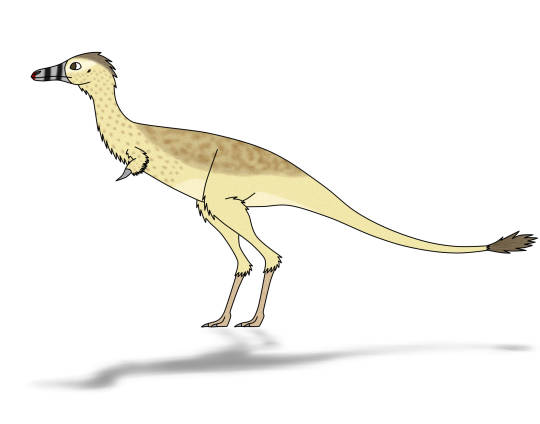
By Jem McCormick on @excessively-english-little-b
PLEASE SUPPORT US ON PATREON. EACH and EVERY DONATION helps to keep this blog running! Any amount, even ONE DOLLAR is APPRECIATED! IF YOU ENJOY THIS CONTENT, please CONSIDER DONATING!
Name: “Ornithomimus” minutus
Name Meaning: Small Bird Mimic
First Described: 1892
Described By: Marsh
Classification: Dinosauria, Theropoda, Neotheropoda, Averostra, Tetanurae, Orionides, Avetheropoda, Coelurosauria, Tyrannoraptora, Maniraptoriformes, Maniraptora, Alvarezsauria, Alvarezsauridae. Parvicursorinae
“Ornithomimus” minutus was originally based on toe bones, and thought to be a separate species of Ornithomimus proper, hence its name. This specimen has been lost, and was also thought to be a species of Dromaeosaurus, or Troodon. It was found in the Denver Basin of Colorado, living in the Maastrichtian age of the Late Cretaceous, approximately 68 million years ago. It has since thought to be the specimen of an Alvarezsaur, with similarities in the toe bone compared to Mononykus. Still, it remains something of a mystery.
Sources:
http://theropoddatabase.com/Ornithomimosauria.htm#Ornithomimusminutus
https://en.wikipedia.org/wiki/Alvarezsauridae
https://en.wikipedia.org/wiki/Ornithomimus
This is your friendly reminder that ADAD relies on reblogs up and until @staff gets it’s shit together. Please reblog this post.
Shout out goes to @thecoffeecoyote!
#ornithomimus minutus#dinosaur#alvarezsaur#theropod#palaeoblr#thecoffeecoyote#paleontology#prehistory#prehistoric life#dinosaurs#biology#a dinosaur a day#a-dinosaur-a-day#dinosaur of the day#dinosaur-of-the-day#science#nature#factfile#Dìneasar#דינוזאור#डायनासोर#ديناصور#ডাইনোসর#risaeðla#ڈایناسور#deinosor#恐龍#恐龙#динозавр#dinosaurio
39 notes
·
View notes